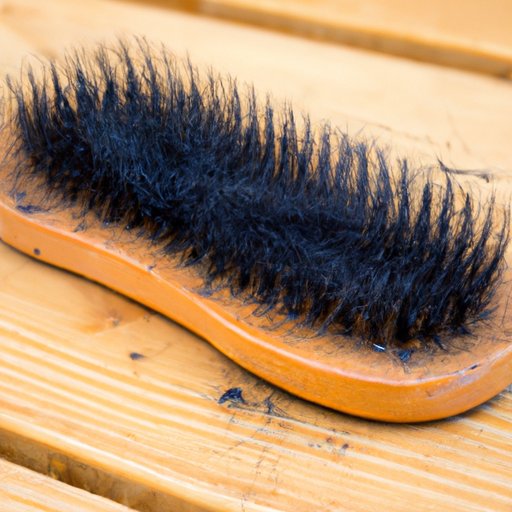
I. Introduction
If you’ve ever found that your hairbrush is covered in lint, you’re not alone. This pesky problem plagues many of us, leading to a tangled mess of hair and debris that not only looks gross but can also damage our brushes. Fortunately, there are several techniques and tips you can use to effectively remove lint from your hairbrush and prevent it from building up in the first place.
II. Tangled Mess: How to Effectively Remove Lint from Your Hairbrush
If you’ve noticed a buildup of lint and debris on your hairbrush, don’t worry – removing it is easier than you might think. Start by using a comb to gently loosen any lint and debris that’s caught in the bristles. Next, use tweezers to carefully pull out any stubborn pieces of lint that the comb can’t remove. If there are still bits of debris left behind, wrap a piece of tape around your hand and press it onto the brush, gently lifting the lint away.
For tougher lint, try soaking your hairbrush in warm water and dish soap for a few minutes before using these techniques. Always be gentle and avoid using excess force, as this can damage the bristles and cause knots in your hair.
III. Quick and Painless: Time-Saving Tips for Cleaning Your Hairbrush
To prevent lint and debris buildup in the first place, aim to clean your hairbrush regularly. Start by simply removing any hair that’s caught in the bristles after each use. For a deeper clean, use a toothbrush to gently scrub away any lint or debris. If you’re dealing with tough buildup, try soaking your brush in a solution of warm water and vinegar before scrubbing.
In addition, consider investing in a brush cleaner tool – these nifty devices have small bristles that can help you thoroughly clean even the tightest spaces between brush bristles.
IV. Natural and Easy: Removing Lint from Hairbrushes Using Natural Ingredients
If you’re looking for a more natural way to remove lint from your hairbrush, try using household ingredients like baking soda, lemon juice, or tea tree oil. Simply mix your chosen ingredient with a small amount of water to create a paste, apply it to your brush, and let it sit for a few minutes. Then, use a toothbrush to gently scrub away any lint or debris before rinsing the brush clean.
While using natural ingredients can be effective, keep in mind that they aren’t always the best option for certain types of brushes, such as those with natural bristles. Additionally, some natural ingredients may not be as effective at removing tough buildup as other methods.
V. Plastic or Bristle? Choosing the Right Hairbrush for Your Hair Type to Reduce Lint
One of the best ways to reduce lint buildup in your hairbrush is to choose the right brush in the first place. Different hair types require different brushes, so be sure to select a brush that’s designed for yours. For example, boar bristle brushes are great for smoothing and detangling thick hair, while plastic brushes with flexible bristles work well for fine hair.
In addition, consider materials that are less prone to collecting lint – metal and plastic brushes are less likely to trap debris than natural bristle brushes. Avoid brushes with padding or cushioned backings, as these can quickly become a magnet for lint and other debris.
VI. DIY Hairbrush Cleaning Station: A Simple Guide to Keeping Your Brush Lint-Free
If you’re serious about keeping your hairbrush clean and lint-free, consider setting up a dedicated station for cleaning your brush. Start by designating a spot in your bathroom or beauty routine where you can easily access your brush and cleaning supplies. Next, gather the tools you need, such as a toothbrush, comb, and vinegar, and keep them in a designated container. Finally, make brush cleaning a regular habit – aim to clean your brush at least once a week to prevent buildup.
VII. Conclusion
Removing lint from hairbrushes can be a frustrating and time-consuming process, but with the right techniques and tools, it’s possible to keep your brush clean and in good condition. Try out different methods, develop a regular cleaning routine, and choose the right brush for your hair type to keep your hair looking its best.
Remember, a clean hairbrush isn’t just good for your hair – it’s also good for your health. By removing built-up lint and debris, you’ll reduce your exposure to dirt, bacteria, and other harmful elements that can cause skin irritation and infection.




